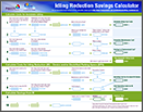Light-Duty Vehicle Idle Reduction Strategies
How Much Can I Save?
Use the Idle Reduction Savings Worksheet to calculate your potential savings.
Light-duty vehicles include passenger cars, sport utility vehicles, and most pickup trucks, as well as fleet vehicles, such as police cruisers, some service vehicles, taxis, and cars used for paid ridesharing services. Drivers of these vehicles have become accustomed to idling vehicles for a number of reasons. Many drivers do not make the connection between idle time, increased emissions, and wasted fuel. Changing driver behavior and using idle reduction technologies can help save fuel, reduce emissions, and save money. See the fact sheet, Idling Reduction for Personal Vehicles, for more information about reducing passenger vehicle idling.
Driver Behavior
For personal vehicles, the primary idle reduction strategy is to turn the engine off when parked or stopped for more than 10 seconds (except in traffic). Drivers can also:
- Avoid using a remote starter, which encourages unnecessary idling.
- Avoid using drive-throughs. Shut off the engine and walk inside instead.
- Obey signs indicating no-idle zones at schools and other locations.
- Consider the purchase of an electric vehicle or one with stop/start technology, both of which eliminate idling at traffic stops and while waiting in queue.
Adopt Idle Reduction Technologies
For conventionally fueled vehicles that must stand for long periods, auxiliary power systems, air heaters, automatic power management systems, and waste-heat recovery systems are good alternatives to idling.
-
Auxiliary Power Systems
Auxiliary power systems provide heating, cooling, and electronic device power without running the vehicle's engine. These systems are useful for police vehicles, which require power for communications, emergency lighting, and HVAC while stopped. Such systems can be powered by lead-acid or lithium-ion batteries and are charged by the vehicle’s engine when the vehicle is being driven.
-
Air Heaters
Drivers more concerned with passenger compartment warmth—such as taxi, limousine, and rideshare drivers—might prefer air heaters. Air heaters are separate, self-contained units that blow warm air directly into the vehicle interior. Although they operate on engine fuel, they use a small fraction of the fuel used by engine idling.
-
Automatic Power Management Systems
Power management systems allow the driver to turn off the vehicle engine and use battery power to run a vehicle's HVAC and other accessories without worrying about battery depletion. The systems monitor battery power levels while the engine is off and battery-powered accessories are on. When battery state-of-charge falls below a preset level, the power management system restarts the engine and keeps it running until the battery is charged to a predetermined level.
-
Waste-Heat Recovery Systems
Another option for keeping a vehicle warm is an energy recovery system, which uses the vehicle's heat-transfer system. A very small electric pump is connected to the water line, which keeps the vehicle's cooling system and heater operating after the engine is turned off by using engine heat that would otherwise dissipate. Energy recovery systems help keep the passenger compartment warm.
